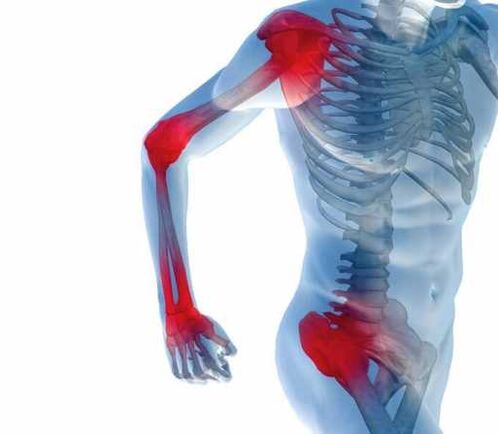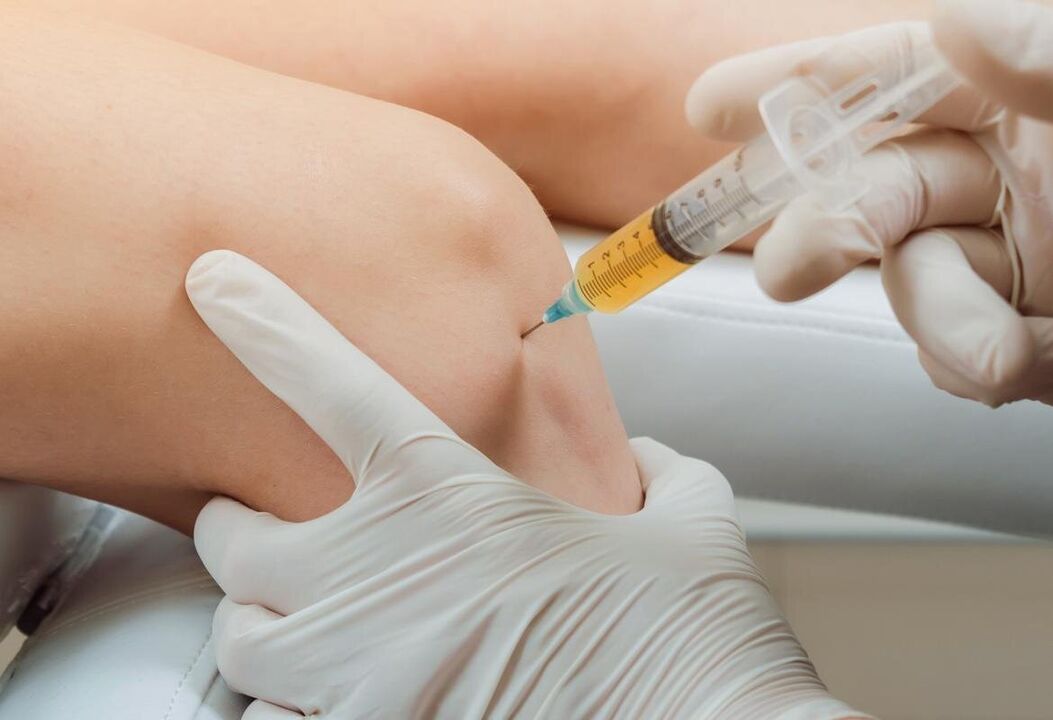
Joint pain(arthralgia) can occur singly or simultaneously in several joints (polyarthralgia). Arthralgias are observed in rheumatic, endocrine, infectious, tumor, neurological, autoimmune diseases, injuries, overweight. Knowing the cause of joint pain has important differential diagnostic importance; performed using X-rays, ultrasound, laboratory, invasive methods (arthrocentesis, arthroscopy). Treatment of arthralgia is reduced to the treatment of the disease that causes it. Symptomatic measures are used (analgesics, local heat, ointments), immobilization, physiotherapy, surgical intervention.
Welding
Arthralgias differ in localization and depth, the number of joints involved, the nature and intensity of the pain syndrome, its daily rhythm, duration of existence, connection with a particular type of movement. With the presence of pain in one joint, they talk about monoarthralgia, with simultaneous or sequential pain syndromes in several joints - about oligoarthralgia, with the involvement of 5 or more joints - about polyarthralgia syndrome.
According to the nature of the arthralgic syndrome, acute and dull pain are distinguished; according to intensity - from weak and moderate to intense; according to the type of flow - temporary and constant. More often, arthralgia occurs in large joints - hips, knees, shoulders and elbows, less often in medium and small - wrists, ankles, interphalangeal.
The occurrence of pain in the joints is promoted by irritation of neuroreceptors of the synovial membrane of the articular capsule with inflammatory mediators, products of the immune response, salt crystals, toxins, osteophytes. In rheumatology, it is customary to distinguish the following types of joint pain:
- caused by toxic syndrome in acute infections;
- primary episodes or intermittent (intermittent) arthralgia in acute or recurrent arthritis;
- long -term monoarthralgia of large joints;
- oligo- or polyarthralgic syndrome accompanied by synovial membrane involvement or progressive degenerative-dystrophic changes in cartilage;
- residual arthralgia after inflammation or after trauma to the joints;
- pseudoarthralgia.
Why do joints hurt
Common infectious diseases
Arthralgic syndrome often accompanies the course of an acute infection. Joint pain can be observed in the prodromal period of the disease, and in the early clinical stage, occurs with fever and intoxication. The infectious form of arthralgia is characterized by "pain" in the lower and upper joints, the nature of polyarticular pain, and its association with myalgia. Mobility in the joints is fully preserved. Usually, infectious arthralgia disappears within a few days as the toxic syndrome caused by the underlying disease worsens.
Infectious arthritis
Possible options for the development of post -infectious reactive arthralgia after acute intestinal or urogenital infections; parainfectious arthralgic syndrome caused by tuberculosis, infective endocarditis, secondary syphilis. Often the cause of pain in the joints is the focus of an existing chronic infection - pyelonephritis, cholangitis, adnexitis, paratonsillar abscess or parasitic invasion.
Residual arthralgia after joint inflammation is chronic or temporary. Pain and stiffness in the joints may persist for weeks or months; in the future, the well -being and function of the limbs is fully restored. In the form of chronic arthralgia, its severity is associated with overstrain, meteorological lability, and hypothermia.

Rheumatic diseases
Poly- or ologarthralgia type joint pain is the main symptom of inflammatory rheumatic disease. Rheumatic arthralgia is characterized by a persistent, intense, migratory pain syndrome, involvement of large joints, especially the lower part of the foot, limited movement of the joints.
The onset of rheumatoid arthritis, as well as systemic rheumatic diseases, is indicated by polyarticular syndrome, which affects the small symmetrical joints of the feet and hands, motor stiffness in the morning.
In microcrystalline gouty arthritis, arthralgia manifests itself in the form of recurrent paroxysmal pain in an isolated joint, which, after a sudden onset, rapidly reaches peak intensity and does not subside for several days.
Degenerative joint lesions
Gradually increasing pain in the joints for a long time may indicate osteoarthritis deformities and other degenerative-dystrophic lesions. In this case, involvement of the knee or hip joint is typical; types of dull, aching, exercise -related aches and disappearances during rest. Arthralgia can be weather -dependent, accompanied by "crunching" of the joints during movement, weakness when using local disorder therapy.
Joint injuries
Bruising, joint dislocation, damage to the ligament apparatus, intra-articular fractures are accompanied by severe pain. The affected joint becomes swollen, deformed, hot to the touch. Lower limb support function is impaired, movement in the joints becomes difficult, and sometimes pathological mobility occurs. Injuries can be accompanied by bleeding into the joint cavity, which leads to stiffness.
Oncological diseases
Persistent oligo- and polyarthralgia of a long course, accompanied by the formation of "Hippocratic fingers" (defects of the nails and distal phalanx such as "clock glass" and "drum rods"), indicate paraneoplastic lesions on the synovial membrane. In such patients, oncological pathology of internal organs, especially lung cancer, should be suspected.
Endocrine diseases
Common causes of joint pain are endocrine disorders - primary hyperparathyroidism, ovariogenic dysfunction, hypothyroidism, obesity. Endocrine genesis articular syndrome occurs in the form of oligoarthralgia associated with ossalgia, myalgia, pain in the pelvic bones and spine.
Another reason
Other possible causes of arthralgia include:
- intoxicated with heavy metals (thallium, beryllium);
- excessive overload or frequent microtrauma to the joints;
- long -term drug therapy;
- post -allergic reactions;
- Flat feet;
- X or O -shaped deformities of the limbs;
- pseudoarthralgia, simulated by primary ossalgia, neuralgia, myalgia, vascular pathology, psychosomatic disorders.
Diagnostics
Since joint pain is only a subjective symptom, clinical and anamnestic features and physical examination emerge when determining the cause of its occurrence. It is necessary to consult a rheumatologist, orthopedist. To distinguish the etiology of arthralgia, several objective studies were conducted:
- X-ray of the joint.It is a routine method that allows you to examine any joint in various diseases. Often, radiography is performed in one or 2 projections, it is also possible to study in a special style, performing contrast arthrography. A more detailed picture of the osteochondral and soft tissue conditions of the joint can be obtained with CT and MRI imaging.
- Ultrasound of the joints.Allows you to detect effusions in the joint cavity, bone erosion, changes in the synovial membrane, measure the width of the joint space. The availability of sonography makes it indispensable for the diagnosis of rheumatic joint pathology.
- invasive methods.According to the signs, joint puncture, synovial membrane biopsy was performed. In disputed cases, diagnostic arthroscopy is performed, which allows to examine the joint cavity from the inside, to carry out diagnostic and therapeutic measures.
- Lab test.Helps identify the presence of inflammatory processes,rheumatic diseases. In peripheral blood, ESR, levels of C-reactive protein, uric acid, specific immunopathological markers (rheumatoid factor, antinuclear antibodies, ACCP) were determined. An important diagnostic method is microbiological examination and cytology of synovial fluid.
- Additional diagnostic methods:thermography, podography.

Treatment
Help before diagnosis
For any pain in the joints, it is necessary to remain calm and not load the limbs. The metabolic cause of arthralgia determines the need for a balanced diet, normalization of weight. With a new injury, it is necessary to apply a cold to the joint, paralyzing the injured limb with a splint or bandage bandage. You can take painkillers or NSAIDs.
Neglect of competent examination and treatment for arthralgia is fraught with the development of irreversible joint dysfunction - rigidity, ankylosis, contracture. Since pain in the joints can serve as a marker of various diseases, it is necessary to consult a doctor if articular syndrome occurs and persists for more than 2 days.
Conservative therapy
In the treatment of joint pain, a major role is given to the treatment of leading pathologies. Arthralgia drug treatment aims to stop the inflammatory process and intra-articular pain. Systemic therapy includes the use of nonsteroidal anti-inflammatory drugs.
With moderate arthralgia or the presence of contraindications to oral administration of drugs, local external therapy is performed with warming, anti-inflammatory ointments and analgesics. Application with dimethyl sulfoxide is applied to the joint area. Articular gymnastics, physiotherapy procedures (drug electrophoresis, magnetotherapy, phonophoresis, UHF therapy) are recommended.
If necessary, periarticular blockade, intra-articular injection of glucocorticoids, chondroprotectors, synovial fluid prosthesis are performed. Promising modern therapeutic methods for chronic articular pathology are ozone therapy, joint plasmolifting, and orthocin therapy.
Surgery
Various types of surgical interventions are allowed for pain in the joints caused by injury, as well as chronic diseases that lead to loss of joint function. They can be done by open method (arthrotomy) or endoscopic (arthroscopy). Depending on the causative disease, the following things are done:
- arthroplasty;
- arthrodesis;
- plastic ligaments;
- joint cavity rehabilitation;
- removal of pathological formations (cysts, intraarticular bodies);
- synvectomy;
- arthroplasty of the joints.






















